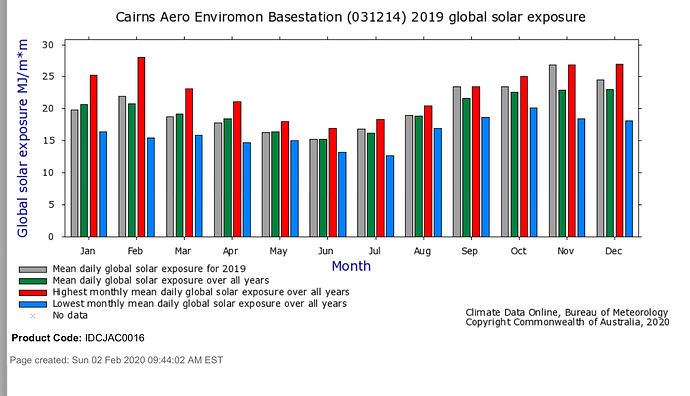According to my surveyor, the difference between True North and Survey North for the survey title plan for my block is 8.5ºW. i.e. True N is west of Survey North in my case. I do not know how much it varies around Australia.
For most people adding panels to an existing house where the roof faced roughly north, it would definitely not be worth worrying about in itself, adding only $50 to a $100 a year in power savings depending on all the associated factors.
However the thread was started by a case where two adjacent 90º/270º set-ups were supposedly identical and yet varied from each other and from a calculator estimate and the reasons (which could be many, and be additive as well as multiplicative) were unknown.
My set up beat my installers quoted estimate by >10% or so for for 2019 (perhaps his calculations were deliberately conservative). It also beat the PVWatts calculator by a smaller margin. I suspect the latter is partly due to last years drought. All calculators have to be based on assumptions which will always vary from actuality.
I have learned through life in business, investing and building, that little things can be additive and/or multiplicative and create a surprising effect over time, particularly when there are a lot of them, as there are with solar installs.
For example, everything from panel consistency to reactions to heat, degradation, low light, cable thickness and length, shade & breeze cooling inverters, micro-cracks in bus bars, life of silicon in roof holes and many more small things are effectively multiplied over time to affect life time cost and benefit.
For example, set up A may be pulled down by one poor panel, or by birds crapping. Set up B may be boosted by a batch of panels which all exceed nominal wattage by 5%. Just saying.
Same as compound interest can give a surprising result over time for two similar interest rates even though the interest difference might be small.
I have found that for a brand new install at least, where I had control over every factor, it was worth maximising all the factors to point in the same positive ‘direction’, including some which are more related to probability or risk, which I care a lot about due to future personal intentions. There are all sorts of future likelihoods such as ability to get a tech up on a roof quickly in a rural area after a cyclone, or other effects relating to climate change or EV use, to name a few.
A business which consistently makes an extra few percent per year on 3 different key things over 4-5 years can send a nearby competitor out of business. It is about ducks lining up or not.
That is just me and my goals for my situation, which would not be the same as for most of the population.

